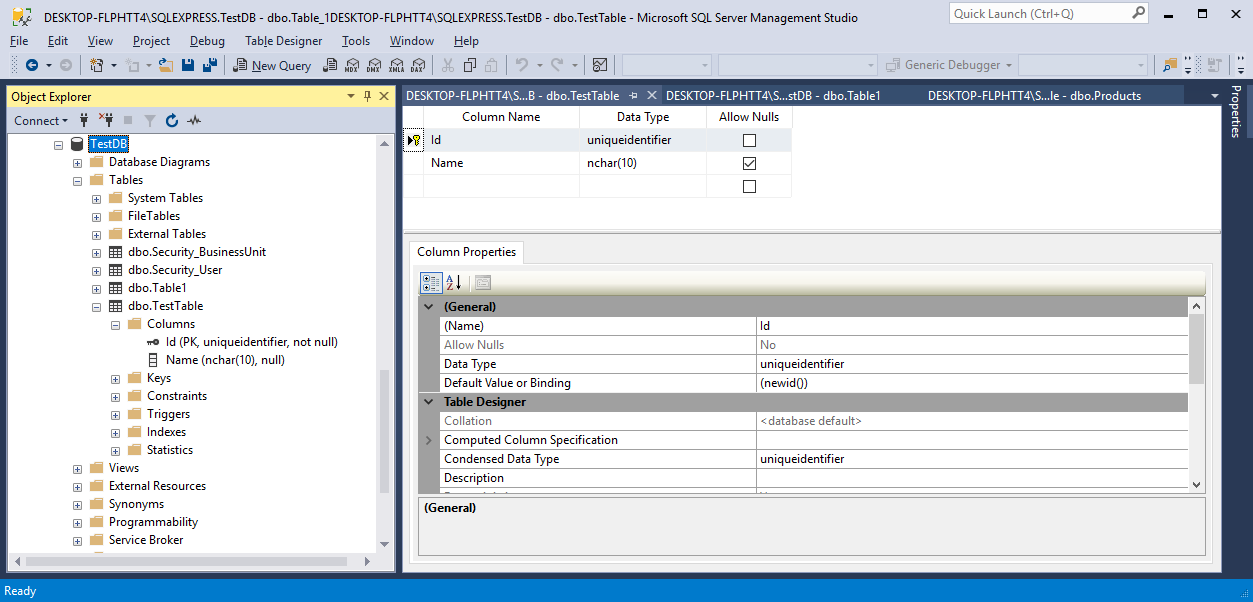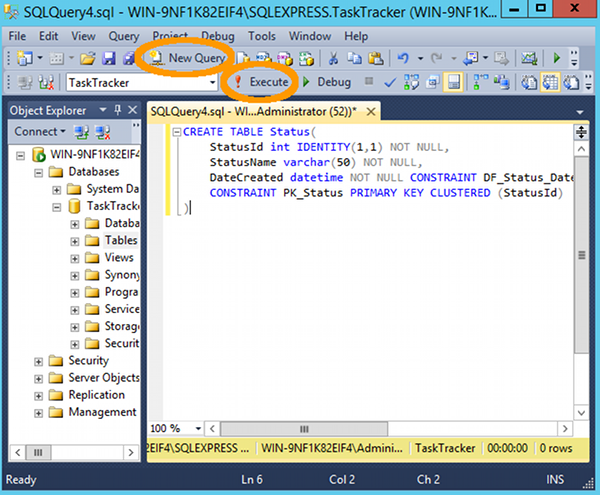Sql Server Generate Guid Primary Key
- Sql Server Generate Guid Primary Key In Excel
- Sql Server Guid Data Type
- Sql Server Create Table Guid Primary Key
- Sql Server Generate Guid Primary Key 2017
- Sql Server Generate Guid Primary Key Mean
You can define a primary key in SQL Server by using SQL Server Management Studio or Transact-SQL. Creating a primary key automatically creates a corresponding unique clustered index, or a nonclustered index if specified as such.
Sql Server Generate Guid Primary Key In Excel
Using SQL Server GUID as primary key. Sometimes, it prefers using GUID values for the primary key column of a table than using integers. Using GUID as the primary key of a table brings the following advantages: GUID values are globally unique across tables, databases, and even servers.
Before You Begin
Using NEWID in a CREATE TABLE statement. Applies to: SQL Server. The following example creates the cust table with a uniqueidentifier data type, and uses NEWID to fill the table with a default value. In assigning the default value of NEWID, each new and existing row has a unique value for the CustomerID column.- Creating a table using NEWID for uniqueidentifier data type. Detriments to GUIDs as a Primary Key: They are large 16 bytes meaning they will consume more space as indexes and foreign keys are added. They do not sort well as they are essentially random numbers. Index usage is very, very, very bad. A lot of leaf moving.
I am designing a table and I have decided to create an auto-generated primary key value as opposed to creating my own scheme or using natural keys. I see that SQL Server offers globally unique identifiers (GUIDs) as well as identities to create these valu. APPLIES TO: SQL Server 2016 and later Azure SQL Database Azure Synapse Analytics (SQL DW) Parallel Data Warehouse. You can define a primary key in SQL Server by using SQL Server Management Studio or Transact-SQL. Creating a primary key automatically creates a corresponding unique clustered index, or a nonclustered index if specified as such. Feb 12, 2017 This is why SQL Server has implemented a newsequentialid function that is suitable for use in clustered indexes, and is probably the right implementation for all UUID PKs. It is probable that there are similar solutions for other databases, certainly PostgreSQL, MySQL and likely the rest. Primary keys should never be exposed, even UUIDs. SQL Server generate GUID using NEWID function – Querychat GUID is a 16 byte binary SQL Server data type that is globally unique across tables, databases, and servers. The term GUID stands for Global Unique Identifier and it is also known as UNIQUEIDENTIFIER.
Limitations and Restrictions
Sql Server Guid Data Type
A table can contain only one PRIMARY KEY constraint.
All columns defined within a PRIMARY KEY constraint must be defined as NOT NULL. If nullability is not specified, all columns participating in a PRIMARY KEY constraint have their nullability set to NOT NULL.
Security
Permissions
Creating a new table with a primary key requires CREATE TABLE permission in the database and ALTER permission on the schema in which the table is being created.
Creating a primary key in an existing table requires ALTER permission on the table.
Using SQL Server Management Studio
To create a primary key
- In Object Explorer, right-click the table to which you want to add a unique constraint, and click Design.
- In Table Designer, click the row selector for the database column you want to define as the primary key. If you want to select multiple columns, hold down the CTRL key while you click the row selectors for the other columns.
- Right-click the row selector for the column and select Set Primary Key.
Crypto key generate rsa modulus 4096. Caution
Sql Server Create Table Guid Primary Key
If you want to redefine the primary key, any relationships to the existing primary key must be deleted before the new primary key can be created. A message will warn you that existing relationships will be automatically deleted as part of this process.
A primary key column is identified by a primary key symbol in its row selector.
If a primary key consists of more than one column, duplicate values are allowed in one column, but each combination of values from all the columns in the primary key must be unique.
If you define a compound key, the order of columns in the primary key matches the order of columns as shown in the table. However, you can change the order of columns after the primary key is created. For more information, see Modify Primary Keys.
Using Transact-SQL
To create a primary key in an existing table

The following example creates a primary key on the column TransactionID in the AdventureWorks database.
To create a primary key in a new table
The following example creates a table and defines a primary key on the column TransactionID in the AdventureWorks database.
To create a primary key with clustered index in a new table

Sql Server Generate Guid Primary Key 2017
The following example creates a table and defines a primary key on the column CustomerID and a clustered index on TransactionID in the AdventureWorks database.